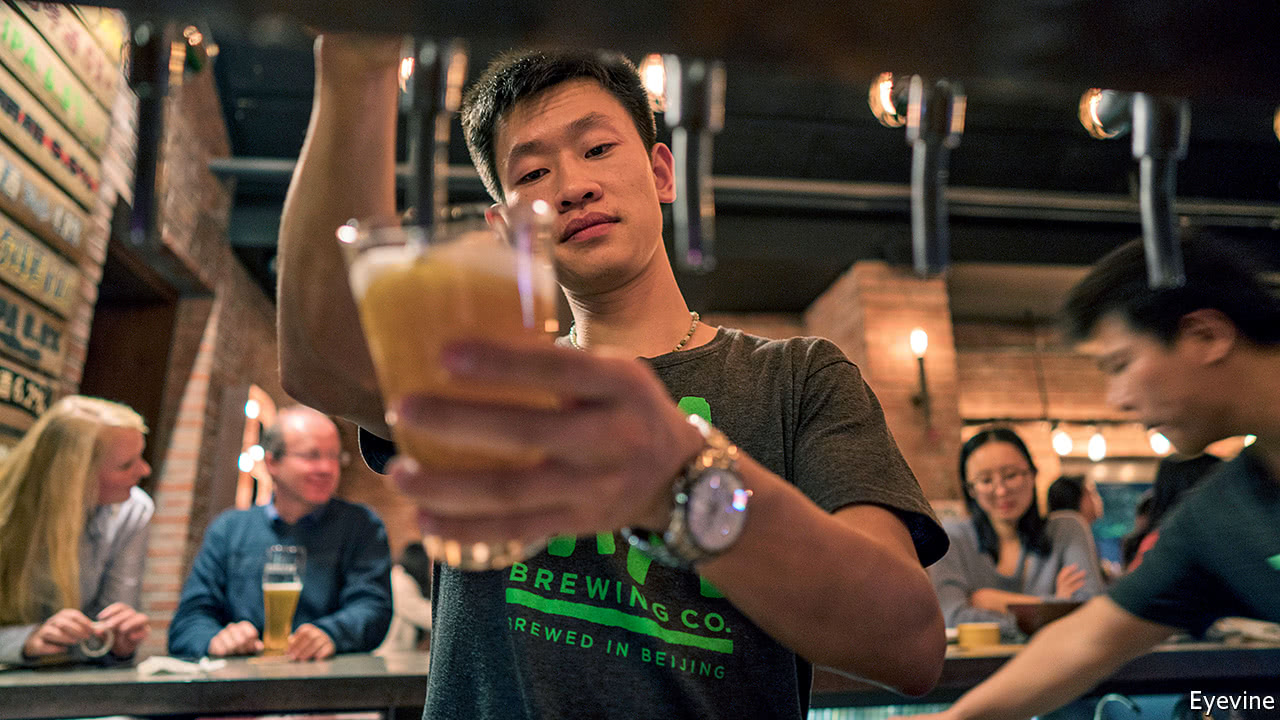
EVIDENCE unearthed at Mijiaya in Shaanxi province proved that the Chinese have an ancient tradition of making beer. Brewers were operating 5,000 years ago, using grains such as millet and Job’s tears (a kind of pearl barley). This year a couple of small-scale brewers lovingly recreated that Neolithic ale. The cloudy, hop-free beverage would challenge even the bravest microbrew devotee. Ladislao Raphael of Moonzen Brewery in Hong Kong describes it as “sour and funky”.
Yet Mr Raphael and his fellow craft-beer evangelists are winning converts. The Chinese market, which is the world’s largest, is dominated by mass-produced lager. But craft breweries are sprouting up around the country—by 2016 there were around 150, up threefold from 2015. Consumption of their brews has surged by two-thirds over the past five years, figures from GlobalData show, even as overall beer-swilling declines. This mirrors a global pattern: consumers often crave better beers as they get richer. Trend-setters in affluent coastal regions are drinking less but pricier beer.
-
Why Stephen King’s novels still resonate
-
Are Americans sacrificing food and clothing to pay their taxes?
-
Retail sales, producer prices, wages and exchange rates
-
Foreign reserves
-
Why “affordable housing” in Africa is rarely affordable
-
What effect is Donald Trump really having on American tourism?
Many craft breweries are foreign-run, but plenty are Chinese-owned too. It was foreigners who initially provided most business for Great Leap Brewing, a stalwart of Beijing’s craft scene, which set up in 2010 in a traditional courtyard down a dusty hutong (alleyway). Now 75% of its customers are locals, says Carl Setzer, its American brewmaster. Panda Brew, founded in Beijing by Pan Dinghao in 2013 with basic home-brewing equipment, recently began exporting to Britain.
Distinctive local tastes have become a feature of the market. Wheat beers are popular, perhaps because they go well with Chinese food and locals like to combine carousing with chewing. Domestic brewers must also make the most of readily available ingredients. Barley in China is mostly poor quality and importing it is costly. Some brewers use exotic items like Sichuan peppers and Oolong tea, which appeal to a sense of local identity.
Doing business in China is rarely hassle-free. Small importers buy craft beer on the grey market and treat it badly, skimping on the cold storage needed to keep it fresh on long journeys to Chinese bars and supermarkets. This risks sullying craft beer’s reputation for quality. Another frowned-on practice is “contract brewing”. Small breweries are subject to rules that stop them selling beyond their premises, which they often circumvent by tapping into bigger brewers’ capacity. Beverages made this way do not always meet craft-beer standards, but are still sold as such.
Yet as demand for craft beer in America softens from recent highs, China’s market still promises much. In March the biggest brewer of them all, Belgium’s AB InBev, bought a stake in a Shanghai brewery called Boxing Cat. Beyond megalopolises such as Shanghai, speciality beers are selling well, even though microbrews can cost ten times as much as locally brewed lager. In contrast to the sour-tasting brews of China’s distant past, craft beer’s future on the mainland looks likely to be sweet.
Source: economist
A craft-beer boom with Chinese characteristics